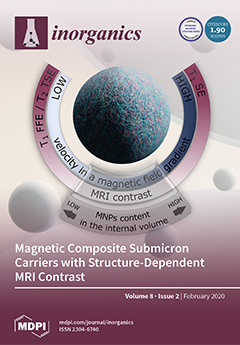Diisocyanide ligands with a
m-terphenyl backbone provide access to Mo
0 complexes exhibiting the same type of metal-to-ligand charge transfer (MLCT) luminescence as the well-known class of isoelectronic Ru
II polypyridines. The luminescence quantum yields and lifetimes of the homoleptic tris(diisocyanide) Mo
[...] Read more.
Diisocyanide ligands with a
m-terphenyl backbone provide access to Mo
0 complexes exhibiting the same type of metal-to-ligand charge transfer (MLCT) luminescence as the well-known class of isoelectronic Ru
II polypyridines. The luminescence quantum yields and lifetimes of the homoleptic tris(diisocyanide) Mo
0 complexes depend strongly on whether methyl- or
tert-butyl substituents are placed in α-position to the isocyanide groups. The bulkier
tert-butyl substituents lead to a molecular structure in which the three individual diisocyanides ligated to one Mo
0 center are interlocked more strongly into one another than the ligands with the sterically less demanding methyl substituents. This rigidification limits the distortion of the complex in the emissive excited-state, causing a decrease of the nonradiative relaxation rate by one order of magnitude. Compared to Ru
II polypyridines, the molecular distortions in the luminescent
3MLCT state relative to the electronic ground state seem to be smaller in the Mo
0 complexes, presumably due to delocalization of the MLCT-excited electron over greater portions of the ligands. Temperature-dependent studies indicate that thermally activated nonradiative relaxation via metal-centered excited states is more significant in these homoleptic Mo
0 tris(diisocyanide) complexes than in [Ru(2,2′-bipyridine)
3]
2+.
Full article





